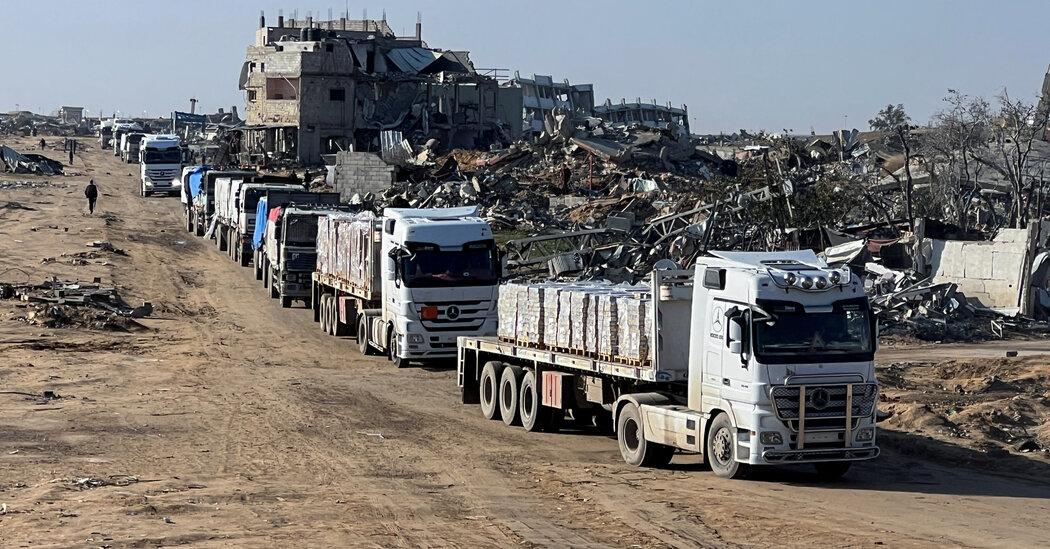Hamas said on Thursday that it was still committed to upholding the cease-fire deal with Israel, including releasing more hostages this weekend, a sign of diplomatic progress amid widespread concern about the future of the precarious truce with Israel.
Mediators between the two sides were following up “to remove obstacles and close gaps” after “positive” talks with senior officials from Egypt and Qatar, Hamas said in a statement. Along with the United States, Egypt and Qatar have been brokering the cease-fire, which began with a six-week truce in late January.
There was no immediate comment from Israel on Hamas’s latest statement. Hamas has consistently said that resuming the hostage releases would depend on Israel’s upholding its end of the deal to the group’s satisfaction.
Basem Naim, a Hamas spokesman, said he believed that the releases would go ahead on Saturday but declined to clarify Hamas’s statement or to definitively confirm that plan.
In late January, both sides agreed to stop the devastating fighting in Gaza, with Hamas agreeing to release at least 33 hostages in exchange for more than 1,500 Palestinians imprisoned by Israel. But over the past few days, officials across the region expressed fear that the truce was at risk amid claims of cease-fire violations between the two sides.
Even if the current roadblock is surmounted, the future of the cease-fire is in question: Israel and Hamas have yet to agree on terms to extend the agreement after the initial six weeks.
Earlier this week, Hamas said that Israel was not upholding its end of the deal, mainly by failing to allow enough tents and other aid into Gaza, and suspended the release of the next few hostages in protest. Benjamin Netanyahu, the Israeli prime minister, then threatened that unless hostages were released by Saturday afternoon, Israel would resume its campaign “until Hamas is conclusively defeated.”
President Trump added a further complication by demanding that all the remaining hostages should be freed by Saturday or “all hell is going to break out.” That message appeared to contradict the cease-fire deal that Mr. Trump’s own envoys had helped to broker, which stipulates a graduated release of hostages for Palestinian prisoners.
Khalil al-Hayya, Hamas’s chief negotiator, recently led a delegation to Egypt for meetings with senior officials in an attempt to resolve the impasse, the group said on Thursday. The talks focused on allowing in heavy equipment for construction and clearing rubble, tents for the hundreds of thousands of displaced Gazans and prefabricated homes, Hamas said, as per the terms laid out by the deal.
Although the United Nations and other aid organizations have reported a major rise in aid overall, Hamas says Israel is allowing in not enough tents and no prefabricated shelters at all.
Omer Dostri, Mr. Netanyahu’s spokesman, confirmed on Thursday that Israel was not allowing any prefabricated homes or heavy machinery into Gaza. He did not explain the rationale or say whether that might change in the future. Israel has at times barred some “dual use” materials from entering Gaza, saying that they could be exploited by Hamas for military purposes.
Three Israeli officials and two mediators, who spoke on the condition of anonymity to discuss a sensitive matter, said earlier this week that Hamas’s claims about not receiving enough tents were accurate. But COGAT, the Israeli military unit that oversees aid deliveries, said in a written response that Hamas’s accusations were “completely false.”
Despite the standoff, the fragile cease-fire was still holding and some tents and other humanitarian aid have been entering Gaza. The United Nations’ relief agency said in a statement on Wednesday that 801 trucks of humanitarian aid entered Gaza that day alone to “seize every opportunity afforded by the cease-fire to scale up” assistance.
But the emergency coordinator in Gaza for the aid agency Doctors Without Borders warned that humanitarian deliveries were not happening quickly enough and that “people are still lacking basic items.”
“We are still not seeing the massive scale-up of humanitarian aid needed in northern Gaza,” the emergency coordinator, Caroline Seguin, wrote in a dispatch from the territory that the agency posted online on Wednesday.
Mr. Trump’s recent interventions in the Middle East have reverberated around the region. Over the past week, he has repeatedly said that the United States should take over Gaza, turn it into the “Riviera of the Middle East” and not allow displaced Palestinians to return to the territory once it has been rebuilt.
Palestinians, other Arabs and many experts in the field have rejected Mr. Trump’s proposal as ethnic cleansing and a war crime, and any such move to empty Gaza would most likely preclude any future chance of a Palestinian state.
Hamas on Thursday called for mass street demonstrations across the Middle East and in Muslim communities elsewhere to protest any plans to force Palestinians from Gaza.
Rawan Sheikh Ahmad contributed reporting.





